Abstract
A study of risk factors for intrauterine growth retardation (IUGR) was conducted among a cohort of 13,914 pregnant women enrolled in the multicenter Vaginal Infections and Prematurity Study. From 23 through 26 weeks of gestational age, cultures of specimens from the vagina and cervix were done for group B streptococci, Neisseria gonorrhoeae, Chlamydia trachomatis, Trichomonas vaginalis, Candida albicans, Gardnerella vaginalis, Mycoplasma hominis, Ureaplasma urealyticum, and anaerobic gram-negative rods belonging to the genera Bacteroides, Porphyromonas, and Prevotella. Newborns who were small for their gestational age were delivered by 1,251 women, and infants of the appropriate weight for their gestational age were delivered by 10,332 women. When controlling for ethnicity and smoking and excluding women treated with antibiotics, the Mantel-Haenszel adjusted relative risk of IUGR was 1.16 for Bacteroides, Prevotella, and Porphyromonas spp. (95% confidence interval [95% CI], 1.01 to 1.33), 1.16 for M. hominis (95% CI, 1.04 to 1.29), 1.20 for U. urealyticum (95% CI, 1.05 to 1.38), and 1.22 for T. vaginalis (95% CI, 1.05 to 1.42). There was also a strong and significant trend for an increasing risk of IUGR with the number of these four microbes recovered. Among women colonized with all four isolates, the adjusted odds ratio of IUGR was 1.79 (95% CI, 1.27 to 2.52) in comparison with women not colonized with any of these microorganisms. Group B streptococci, N. gonorrhoeae, C. trachomatis, and C. albicans were not significantly associated with IUGR. These results suggest that infection is associated with some cases of IUGR and that specific microorganisms, alone or in combination, are involved. Since genital isolates are highly correlated with each other, the relative contribution of each microbe is difficult to determine.
Full text
PDF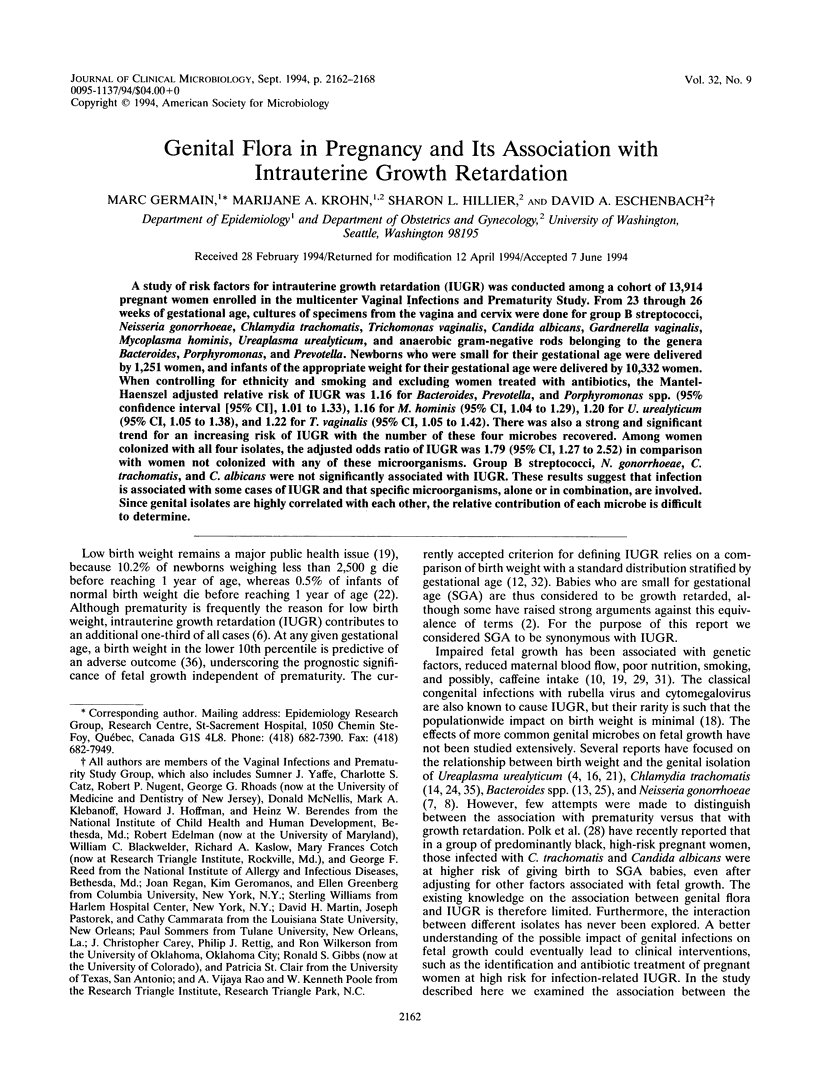

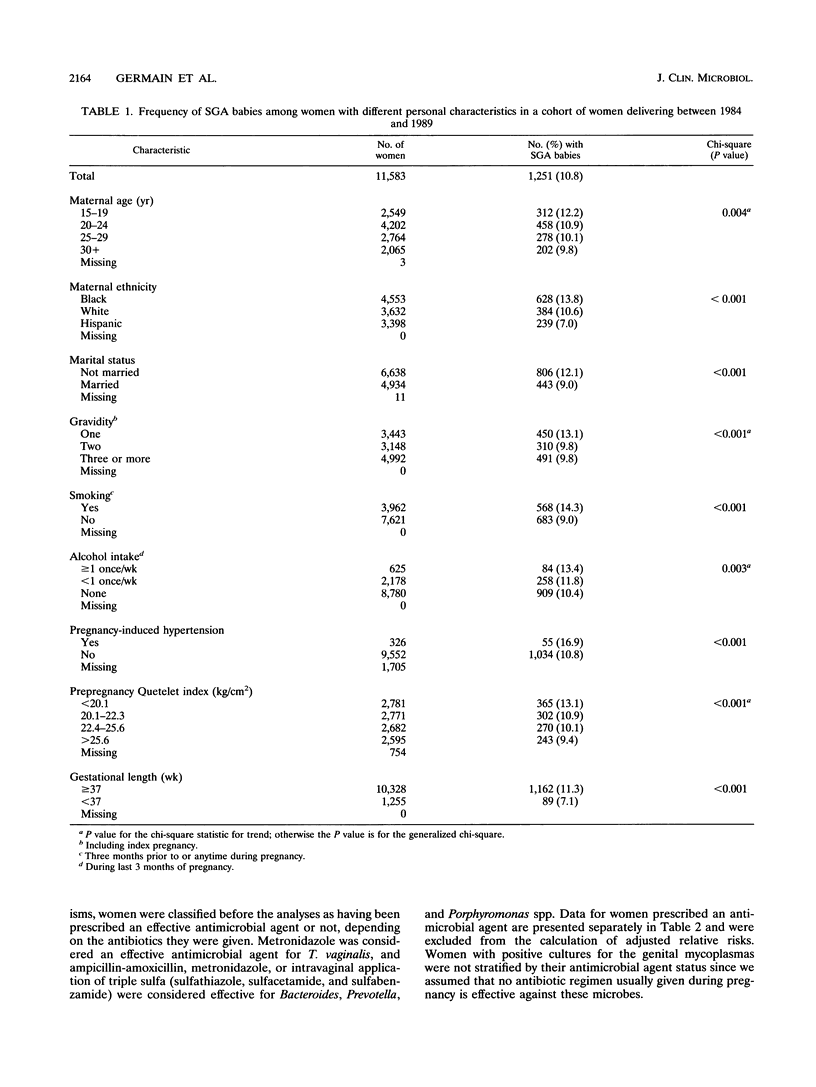
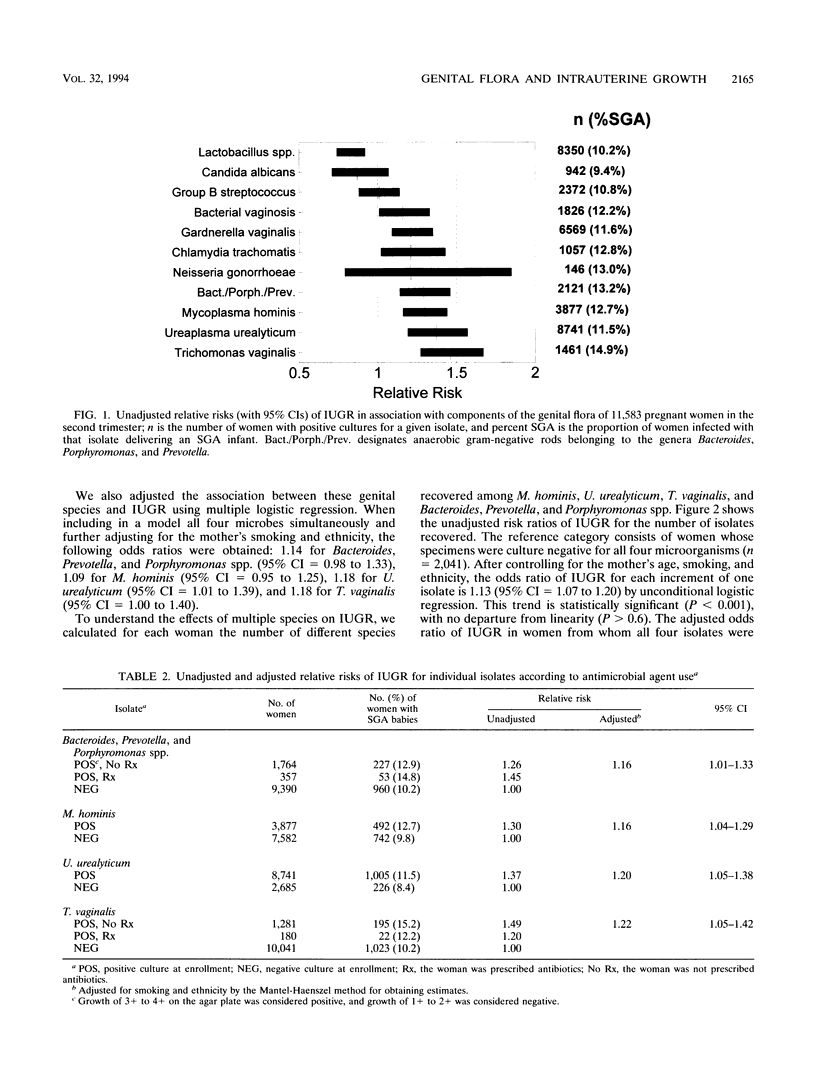
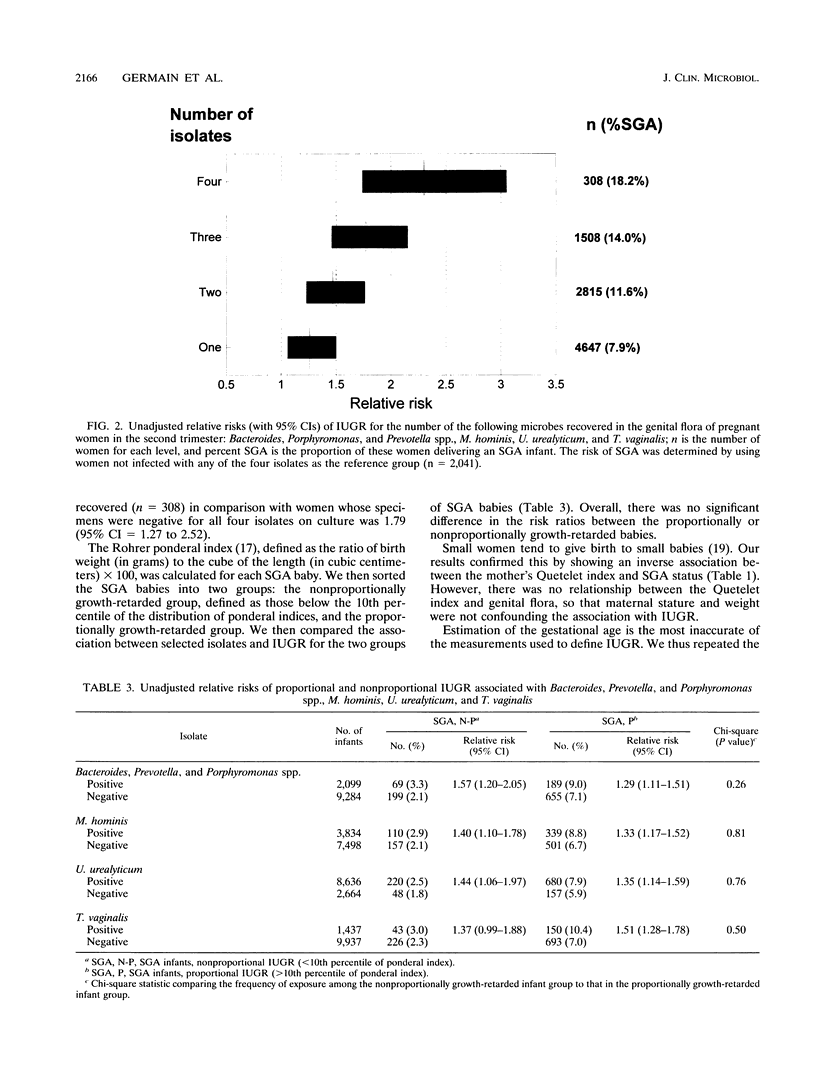
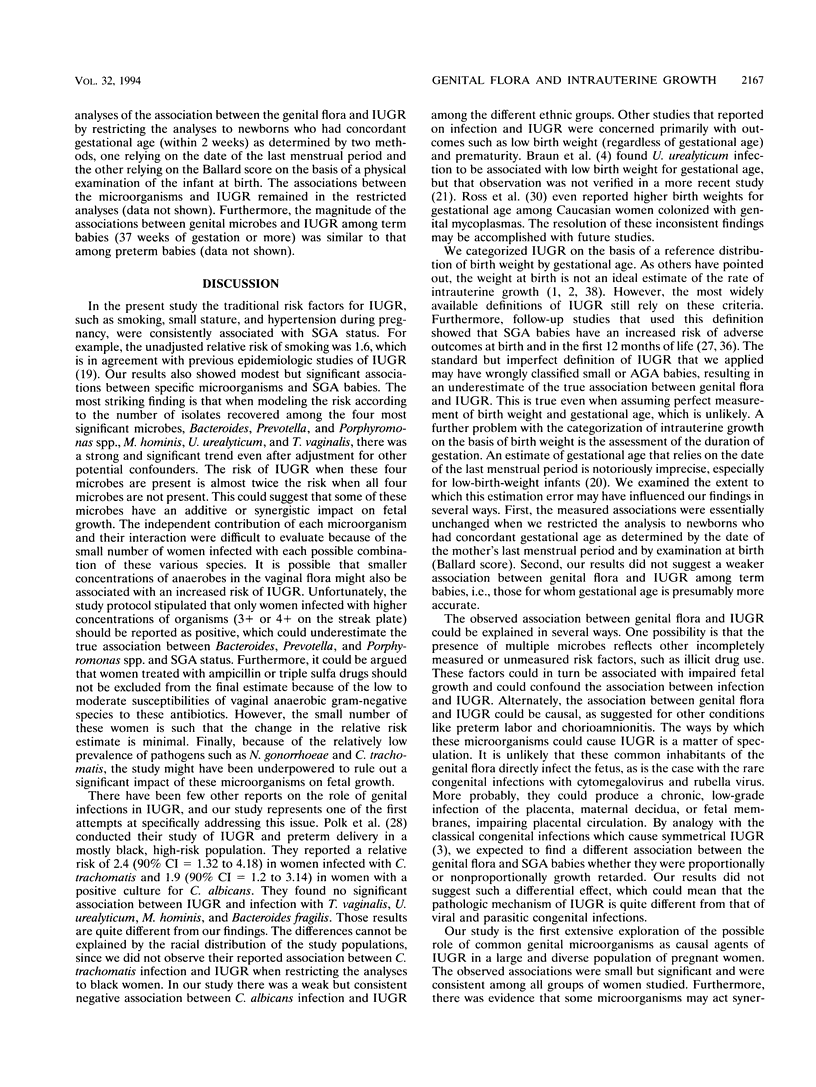
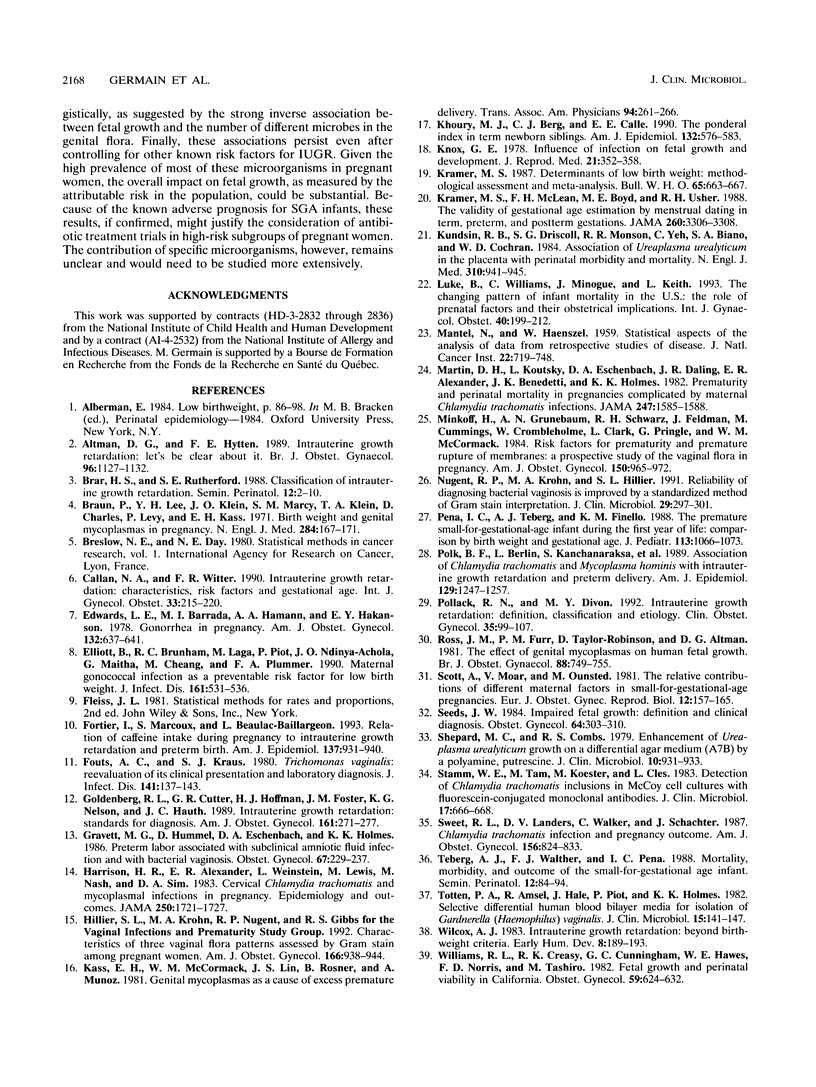
Selected References
These references are in PubMed. This may not be the complete list of references from this article.
- Altman D. G., Hytten F. E. Intrauterine growth retardation: let's be clear about it. Br J Obstet Gynaecol. 1989 Oct;96(10):1127–1132. doi: 10.1111/j.1471-0528.1989.tb03185.x. [DOI] [PubMed] [Google Scholar]
- Association of Chlamydia trachomatis and Mycoplasma hominis with intrauterine growth retardation and preterm delivery. The John Hopkins Study of Cervicitis and Adverse Pregnancy Outcome. Am J Epidemiol. 1989 Jun;129(6):1247–1257. doi: 10.1093/oxfordjournals.aje.a115244. [DOI] [PubMed] [Google Scholar]
- Brar H. S., Rutherford S. E. Classification of intrauterine growth retardation. Semin Perinatol. 1988 Jan;12(1):2–10. [PubMed] [Google Scholar]
- Braun P., Lee Y. H., Klein J. O., Marcy S. M., Klein T. A., Charles D., Levy P., Kass E. H. Birth weight and genital mycoplasmas in pregnancy. N Engl J Med. 1971 Jan 28;284(4):167–171. doi: 10.1056/NEJM197101282840401. [DOI] [PubMed] [Google Scholar]
- Callan N. A., Witter F. R. Intrauterine growth retardation: characteristics, risk factors and gestational age. Int J Gynaecol Obstet. 1990 Nov;33(3):215–220. doi: 10.1016/0020-7292(90)90004-5. [DOI] [PubMed] [Google Scholar]
- Edwards L. E., Barrada M. I., Hamann A. A., Hakanson E. Y. Gonorrhea in pregnancy. Am J Obstet Gynecol. 1978 Nov 15;132(6):637–641. doi: 10.1016/0002-9378(78)90856-6. [DOI] [PubMed] [Google Scholar]
- Elliott B., Brunham R. C., Laga M., Piot P., Ndinya-Achola J. O., Maitha G., Cheang M., Plummer F. A. Maternal gonococcal infection as a preventable risk factor for low birth weight. J Infect Dis. 1990 Mar;161(3):531–536. doi: 10.1093/infdis/161.3.531. [DOI] [PubMed] [Google Scholar]
- Fortier I., Marcoux S., Beaulac-Baillargeon L. Relation of caffeine intake during pregnancy to intrauterine growth retardation and preterm birth. Am J Epidemiol. 1993 May 1;137(9):931–940. doi: 10.1093/oxfordjournals.aje.a116763. [DOI] [PubMed] [Google Scholar]
- Fouts A. C., Kraus S. J. Trichomonas vaginalis: reevaluation of its clinical presentation and laboratory diagnosis. J Infect Dis. 1980 Feb;141(2):137–143. doi: 10.1093/infdis/141.2.137. [DOI] [PubMed] [Google Scholar]
- Goldenberg R. L., Cutter G. R., Hoffman H. J., Foster J. M., Nelson K. G., Hauth J. C. Intrauterine growth retardation: standards for diagnosis. Am J Obstet Gynecol. 1989 Aug;161(2):271–277. doi: 10.1016/0002-9378(89)90497-3. [DOI] [PubMed] [Google Scholar]
- Gravett M. G., Hummel D., Eschenbach D. A., Holmes K. K. Preterm labor associated with subclinical amniotic fluid infection and with bacterial vaginosis. Obstet Gynecol. 1986 Feb;67(2):229–237. doi: 10.1097/00006250-198602000-00013. [DOI] [PubMed] [Google Scholar]
- Harrison H. R., Alexander E. R., Weinstein L., Lewis M., Nash M., Sim D. A. Cervical Chlamydia trachomatis and mycoplasmal infections in pregnancy. Epidemiology and outcomes. JAMA. 1983 Oct 7;250(13):1721–1727. [PubMed] [Google Scholar]
- Hillier S. L., Krohn M. A., Nugent R. P., Gibbs R. S. Characteristics of three vaginal flora patterns assessed by gram stain among pregnant women. Vaginal Infections and Prematurity Study Group. Am J Obstet Gynecol. 1992 Mar;166(3):938–944. doi: 10.1016/0002-9378(92)91368-k. [DOI] [PubMed] [Google Scholar]
- Kass E. H., McCormack W. M., Lin J. S., Rosner B., Munoz A. Genital mycoplasmas as a cause of excess premature delivery. Trans Assoc Am Physicians. 1981;94:261–266. [PubMed] [Google Scholar]
- Khoury M. J., Berg C. J., Calle E. E. The ponderal index in term newborn siblings. Am J Epidemiol. 1990 Sep;132(3):576–583. doi: 10.1093/oxfordjournals.aje.a115694. [DOI] [PubMed] [Google Scholar]
- Knox G. E. Influence of infection on fetal growth and development. J Reprod Med. 1978 Dec;21(6):352–358. [PubMed] [Google Scholar]
- Kramer M. S., McLean F. H., Boyd M. E., Usher R. H. The validity of gestational age estimation by menstrual dating in term, preterm, and postterm gestations. JAMA. 1988 Dec 9;260(22):3306–3308. [PubMed] [Google Scholar]
- Kundsin R. B., Driscoll S. G., Monson R. R., Yeh C., Biano S. A., Cochran W. D. Association of Ureaplasma urealyticum in the placenta with perinatal morbidity and mortality. N Engl J Med. 1984 Apr 12;310(15):941–945. doi: 10.1056/NEJM198404123101502. [DOI] [PubMed] [Google Scholar]
- Luke B., Williams C., Minogue J., Keith L. The changing pattern of infant mortality in the US: the role of prenatal factors and their obstetrical implications. Int J Gynaecol Obstet. 1993 Mar;40(3):199–212. doi: 10.1016/0020-7292(93)90832-h. [DOI] [PubMed] [Google Scholar]
- MANTEL N., HAENSZEL W. Statistical aspects of the analysis of data from retrospective studies of disease. J Natl Cancer Inst. 1959 Apr;22(4):719–748. [PubMed] [Google Scholar]
- Martin D. H., Koutsky L., Eschenbach D. A., Daling J. R., Alexander E. R., Benedetti J. K., Holmes K. K. Prematurity and perinatal mortality in pregnancies complicated by maternal Chlamydia trachomatis infections. JAMA. 1982 Mar 19;247(11):1585–1588. [PubMed] [Google Scholar]
- Minkoff H., Grunebaum A. N., Schwarz R. H., Feldman J., Cummings M., Crombleholme W., Clark L., Pringle G., McCormack W. M. Risk factors for prematurity and premature rupture of membranes: a prospective study of the vaginal flora in pregnancy. Am J Obstet Gynecol. 1984 Dec 15;150(8):965–972. doi: 10.1016/0002-9378(84)90392-2. [DOI] [PubMed] [Google Scholar]
- Nugent R. P., Krohn M. A., Hillier S. L. Reliability of diagnosing bacterial vaginosis is improved by a standardized method of gram stain interpretation. J Clin Microbiol. 1991 Feb;29(2):297–301. doi: 10.1128/jcm.29.2.297-301.1991. [DOI] [PMC free article] [PubMed] [Google Scholar]
- Pena I. C., Teberg A. J., Finello K. M. The premature small-for-gestational-age infant during the first year of life: comparison by birth weight and gestational age. J Pediatr. 1988 Dec;113(6):1066–1073. doi: 10.1016/s0022-3476(88)80584-5. [DOI] [PubMed] [Google Scholar]
- Pollack R. N., Divon M. Y. Intrauterine growth retardation: definition, classification, and etiology. Clin Obstet Gynecol. 1992 Mar;35(1):99–107. doi: 10.1097/00003081-199203000-00015. [DOI] [PubMed] [Google Scholar]
- Ross J. M., Furr P. M., Taylor-Robinson D., Altman D. G., Coid C. R. The effect of genital mycoplasmas on human fetal growth. Br J Obstet Gynaecol. 1981 Jul;88(7):749–755. doi: 10.1111/j.1471-0528.1981.tb01278.x. [DOI] [PubMed] [Google Scholar]
- Scott A., Moar V., Ounsted M. The relative contributions of different maternal factors in small-for-gestational-age pregnancies. Eur J Obstet Gynecol Reprod Biol. 1981 Sep;12(3):157–165. doi: 10.1016/0028-2243(81)90071-x. [DOI] [PubMed] [Google Scholar]
- Seeds J. W. Impaired fetal growth: definition and clinical diagnosis. Obstet Gynecol. 1984 Sep;64(3):303–310. [PubMed] [Google Scholar]
- Shepard M. C., Combs R. S. Enhancement of Ureaplasma urealyticum growth on a differential agar medium (A7B) by a polyamine, putrescine. J Clin Microbiol. 1979 Dec;10(6):931–933. doi: 10.1128/jcm.10.6.931-933.1979. [DOI] [PMC free article] [PubMed] [Google Scholar]
- Stamm W. E., Tam M., Koester M., Cles L. Detection of Chlamydia trachomatis inclusions in Mccoy cell cultures with fluorescein-conjugated monoclonal antibodies. J Clin Microbiol. 1983 Apr;17(4):666–668. doi: 10.1128/jcm.17.4.666-668.1983. [DOI] [PMC free article] [PubMed] [Google Scholar]
- Sweet R. L., Landers D. V., Walker C., Schachter J. Chlamydia trachomatis infection and pregnancy outcome. Am J Obstet Gynecol. 1987 Apr;156(4):824–833. doi: 10.1016/0002-9378(87)90338-3. [DOI] [PubMed] [Google Scholar]
- Teberg A. J., Walther F. J., Pena I. C. Mortality, morbidity, and outcome of the small-for-gestational age infant. Semin Perinatol. 1988 Jan;12(1):84–94. [PubMed] [Google Scholar]
- Totten P. A., Amsel R., Hale J., Piot P., Holmes K. K. Selective differential human blood bilayer media for isolation of Gardnerella (Haemophilus) vaginalis. J Clin Microbiol. 1982 Jan;15(1):141–147. doi: 10.1128/jcm.15.1.141-147.1982. [DOI] [PMC free article] [PubMed] [Google Scholar]
- Wilcox A. J. Intrauterine growth retardation: beyond birthweight criteria. Early Hum Dev. 1983 Oct;8(3-4):189–193. doi: 10.1016/0378-3782(83)90001-4. [DOI] [PubMed] [Google Scholar]
- Williams R. L., Creasy R. K., Cunningham G. C., Hawes W. E., Norris F. D., Tashiro M. Fetal growth and perinatal viability in California. Obstet Gynecol. 1982 May;59(5):624–632. [PubMed] [Google Scholar]


